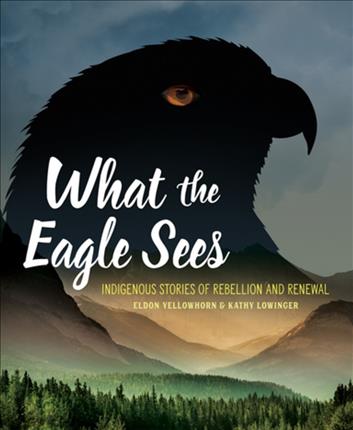| What the eagle sees : indigenous stories of rebellion and renewal Author: Yellowhorn, Eldon | ||
| Price: $12.26 | ||
Summary:
What do people do when their civilization is invaded? Indigenous people have been faced with disease, war, broken promises, and forced assimilation. Despite crushing losses and insurmountable challenges, they formed new nations from the remnants of old ones, they adopted new ideas and built on them, they fought back, and they kept their cultures alive.
| Added Entry - Personal Name: | Lowinger, Kathy |
| Accelerated Reader Information: Interest Level: UG Reading Level: 7.60 Points: 5.0 Quiz: 516965 |
Full Text Reviews:
Booklist - 10/15/2019 *Starred Review* In Turtle Island (2017), Yellowhorn and Lowinger detailed North American Indigenous history up to 1492; here they document the resistance and resilience of Native peoples from European contact to the present. Thematic chapters explore early Viking settlements, slavery (especially as practiced by the Spanish), the prevalence of confederacies allying Indigenous groups, participation in wars (particularly the WWII Navajo code talkers), the changes horses brought to Indigenous society, forced migrations and massacres, attempts to assimilate Indigenous peoples into white society, prohibitions of Indigenous cultural activities, contemporary efforts toward reconciliation, and recognition of traditional knowledge. The tone is informative without becoming accusatory; indeed the facts (many of which will be new to young readers) speak clearly on their own. The choice of narrative style, inclusion of examples from all parts of North America, and an emphasis on personal stories over court decisions all result in a work that is highly accessible (and of interest) to a wide audience. Colorful, captioned illustrations (a mix of contemporary photographs, maps, and period reproductions) appear on almost every page, and numerous sidebars highlight topics of special interest. Framed with a discussion of the eagle and its importance to many Indigenous groups, Yellowhorn (a member of the Piikani Nation) and Lowinger have crafted a worthy and important addition to the historical record. - Copyright 2019 Booklist.
School Library Journal - 12/01/2019 Gr 6 Up—This eclectic work of nonfiction shares several stories about the struggles and survival of Indigenous people across North America, primarily focusing on Canada and the United States. The text is told from an Indigenous perspective and highlights several different Nations and time periods, not necessarily in chronological order. Colorful maps, photos, and illustrations break up the text, making it easily readable. Sidebars give more information about time periods and ask readers to imagine themselves in the shoes of the Indigenous people. The authors clearly detail the harm that colonists and the government inflicted on Indigenous people throughout history to the present day. The scale of the loss of land, culture, and lives is made obvious throughout the text. A glossary of helpful terms, a list of selected sources, and a comprehensive index conclude the volume. This book is highly engaging and educational, though the organization of material (broken up by chapters such as "Slavery," "New Days," "Assimilation," and "Our Day Is Not Over" rather than time period or tribe) may prove challenging for readers hoping to use it for a school project. VERDICT Overall, the combination of modern and historical insight is extremely effective. A valuable resource for anyone seeking to learn more about Indigenous history and a vital purchase for all collections.—Kelsey Socha, Ventress Memorial Library, Marshfield, MA - Copyright 2019 Publishers Weekly, Library Journal and/or School Library Journal used with permission.
School Library Journal - 01/01/2020 Gr 6 Up—This eclectic work of nonfiction shares several stories about the struggles and survival of Indigenous people across North America, primarily focusing on Canada and the United States. The text is told from an Indigenous perspective and highlights several different Nations and time periods, not necessarily in chronological order. Colorful maps, photos, and illustrations break up the text, making it easily readable. Sidebars give more information about time periods and ask readers to imagine themselves in the shoes of the Indigenous people. The authors clearly detail the harm that colonists and the government inflicted on Indigenous people throughout history to the present day. The scale of the loss of land, culture, and lives is made obvious throughout the text. A glossary of helpful terms, a list of selected sources, and a comprehensive index conclude the volume. This book is highly engaging and educational, though the organization of material (broken up by chapters such as "Slavery," "New Days," "Assimilation," and "Our Day Is Not Over" rather than time period or tribe) may prove challenging for readers hoping to use it for a school project.VERDICT Overall, the combination of modern and historical insight is extremely effective. A valuable resource for anyone seeking to learn more about Indigenous history and a vital purchase for all collections.—Kelsey Socha, Ventress Memorial Library, Marshfield, MA - Copyright 2020 Publishers Weekly, Library Journal and/or School Library Journal used with permission.


